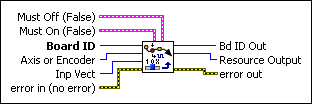 |
Must Off is the bitmap of breakpoint outputs to force Off:
 |
1—If true, breakpoint output is forced Off. If false, breakpoint output is unchanged (default). |
 |
2—If true, breakpoint output is forced Off. If false, breakpoint output is unchanged (default). |
 |
3—If true, breakpoint output is forced Off. If false, breakpoint output is unchanged (default). |
 |
4—If true, breakpoint output is forced Off. If false, breakpoint output is unchanged (default). |
 |
5—If true, breakpoint output is forced Off. If false, breakpoint output is unchanged (default). |
 |
6—If true, breakpoint output is forced Off. If false, breakpoint output is unchanged (default). |
 |
7—If true, breakpoint output is forced Off. If false, breakpoint output is unchanged (default). |
 |
8—If true, breakpoint output is forced Off. If false, breakpoint output is unchanged (default). |
|
 |
Must On is the bitmap of breakpoint outputs to force On:
 |
1—If true, breakpoint output forced On. If false, breakpoint output unchanged (default). |
 |
2—If true, breakpoint output forced On. If false, breakpoint output unchanged (default). |
 |
3—If true, breakpoint output forced On. If false, breakpoint output unchanged (default). |
 |
4—If true, breakpoint output forced On. If false, breakpoint output unchanged (default). |
 |
5—If true, breakpoint output forced On. If false, breakpoint output unchanged (default). |
 |
6—If true, breakpoint output forced On. If false, breakpoint output unchanged (default). |
 |
7—If true, breakpoint output forced On. If false, breakpoint output unchanged (default). |
 |
8—If true, breakpoint output forced On. If false, breakpoint output unchanged (default). |
|
 |
Board ID is a unique number assigned by Measurement & Automation Explorer (MAX) used to send and receive commands and data to or from a specific NI motion controller. |
 |
Axis or Encoder is the axis or encoder selector. To set breakpoint outputs on multiple axes, use 0 (zero). To set breakpoint outputs on multiple encoder resources, use 0x20. |
 |
Inp Vect indicates the source of the data for this VI. Specifically, Inp Vect inputs the location of the Must On parameter. The Must Off is simply the next onboard variable location. Inp Vect is not a bitmap of the breakpoint outputs. Refer to Input and Return Vectors for more detailed information. |
 |
error in (no error) describes error conditions that occur before this VI runs. The default input of this cluster is no error. If an error already occurred, this VI returns the value of error in in error out. The VI runs normally only if no incoming error exists. Otherwise, the VI passes the error in value to error out. The error in cluster contains the following parameters:
 |
status is TRUE if an error occurred before this VI was called, or FALSE if not. If status is TRUE, code is a nonzero error code. If status is FALSE, code is zero or a warning code. |
 |
code is a number identifying an error or warning. If status is TRUE, code is a nonzero error code. If status is FALSE, code is zero or a warning code. Use the error handler VIs to look up the meaning of this code and display the corresponding error message. |
 |
source is a string that indicates the origin of the error, if any. Typically, source is the name of the VI in which the error occurred. |
|
 |
Bd ID Out is provided for flow control. You can string together NI-Motion VIs by wiring the Board ID Out terminal of one VI to the Board ID terminal of the next VI. |
 |
Resource Output is the Axis, Vector Space, ADC, or Encoder you wired into the VI. Use Resource Output to pass the resource to another VI and/or to display information about the device. |
 |
error out contains error information. If error in indicates an error, error out contains the same error information. Otherwise, it describes the error status that this VI produces.
 |
status is TRUE if an error occurred, or FALSE if not. If status is TRUE, code is a nonzero error code. If status is FALSE, code is zero or a warning code. |
 |
code is a number identifying an error or warning. If status is TRUE, code is a nonzero error code. If status is FALSE, code is zero or a warning code. Use the error handler VIs to look up the meaning of this code and display the corresponding error message. |
 |
source is a string that indicates the origin of the error, if any. Typically, source is the name of the VI in which the error occurred. |
|
The Set Breakpoint Output MOMO VI directly controls the breakpoint outputs and sets them high or low. You can use this VI to set breakpoint outputs to a known state or to control them as general-purpose outputs in non-breakpoint applications. You can only control the output using this VI if the breakpoint is disabled.
Breakpoint functionality is performed by the encoder resources themselves. When this VI is sent to axes, the NI-Motion firmware consults the mapping of axes to encoders and actually sends the command to the mapped encoder resources. Breakpoints are only available on encoder resources. Refer to Encoders for encoder resource IDs.


















